Please Respond To This Poll:
So, I’m pretty happy with the way things are going here, but I want to make sure I’m meeting readers’ needs. Please take a moment to make a choice in the poll below. Let me explain my reasoning. Right now I post on Thursdays with the subject matter more or less being songwriting, recording, production and commercial release. Then on Fridays I also post - that post is geared more toward playing guitar and music theory. Engagement goes back and forth between the two days without a readily discernible pattern, and at roughly the same percentage of subscribers engaging with either day. Substack is doing a really good job of providing authors with more data analysis tools, and even at that the best I can come up with is some people like the Thursday posts, and some people like the Friday posts, and there is some overlap, but how much is difficult to determine. So I’ve been considering different approaches, and decided a reasonably simple poll might be helpful. No matter what, Mika, the Cat will still welcome new subscribers! We’ll still have most of the topical subdivisions, at least until I can figure out which ones are most valuable to you all, and which aren’t. This is my first hack at a poll, so I’ll explain what I mean by the questions:
Option 1 is just status quo, I don’t change anything.
Option 2 means I reduce to one post a week, probably Fridays, but each post covers a range of topics, including but not limited to the ones we cover now over both days: Songwriting, recording, production, and commercial release, playing guitar, and music theory. The probable result is a more diversified (some might see it as “cluttered”) post covering a wider range of topics.
Option 3 means I reduce to one post a week, probably Friday, and keep the list of subjects I have now for both days, but focus on just one topic each week. Topics: Songwriting, recording, production, and commercial release, playing guitar, and music theory. Probably a “cleaner” look at a single topic, but maybe not the topic you’re interested in reading that week.
I’m open to suggestions and comments!
Welcome to The Famous Thursday Post!
Our focus on Thursdays is on songwriting, recording, production and commercial release.
Last week we talked about room setup for home recording, usually in a basement or repurposed bedroom or some space along those lines. This week we’ll talk next steps to optimize your space for recording. Cold, hard truth - you can often get a pretty good sound from a home studio setup, with acoustic treatment on the walls, bass traps in the ceiling and wall corners, especially the four places where two walls and the ceiling come together (if your room has additional “2 walls and ceiling corners” because of a partition wall or something, your mileage will definitely vary). But, even with the software correction we’ll talk about today and experience with your DAW, you’re likely not going to achieve the same results as a professional studio space, though you can come mighty close, as many others have proven in the past. Even if your in-home studio becomes a mostly really great rehearsal space with your DAW providing rapid, high quality feedback to you, it’s worth the cost and effort. It can noticeably reduce your paid, professional studio session times via fewer, “cleaner” takes (read that as “$money$”!!!).
For reference, I’m going to include this link that was in last week’s post, because it’s one of the best I’ve found at explaining things: Room Setup (plus it has a lot of links itself to other helpful articles on related subjects).
This week we’re talking about using software and a specialized microphone to determine some helpful ways to “calibrate” your studio/room before and after setup. The software I use (free, but the developers have a donation system and I highly recommend a donation for their efforts - it’s really top notch stuff) is “Room EQ Wizard” (REW) - Link here> Room EQ Wizard
The microphone I chose to use with the software is the analog mic the REW software developers recommended for use with an interface, the Dayton Audio EMM-6 measurement microphone. Not overly expensive, definitely did the job. If you don’t have an audio interface (I use Focusrite, but your mileage may vary and they aren’t paying me to recommend them), there is a USB microphone the developers recommend. Whichever option you use, start with the room as empty as possible for a “baseline” graph, and you may want to conduct additional measurements as you add acoustic treatment - the goal is to end up with graph as “flat” as possible, and a room as acoustically “dead” as possible. I will say that after treating the room and running several calibration tests, I ended up with pretty good results for both. The graph for my studio is pretty flat, probably as flat as I can get it with a couple of windows that face onto a street, and pretty “dead”. The difference with the door to the room open, and (when traffic is quiet in the evening) with the door closed is impressive - definitely noticeable and very “flat” - little or no echo. It’s an odd feeling to realize how much echo is in other rooms in the house that I never really noticed until being in my flat, acoustically “dead” studio room.
That’s my experience, anyway, and the result of a do-it-yourself studio is rewarding, though labor intensive for a week or so. If you read the room setup article and follow the instructions for the software, the results, if maybe not quite “paid professional” level, can be surprisingly close.
A Few Links:
From Carvin:
Compression - this link relates to using a compression plugin. Plugins are software items that come stock with your DAW software, or that you can purchase from various commercial sources. Plugins are used on your DAW’s “channel strips”, one of the two main windows a DAW uses. Note: Apple’s entry level recording software, GarageBand, only displays the “Tracks” window - you have to upgrade to Logic Pro X to see both the “Tracks” and “Channel Strip” windows. Channel strips are sometimes referred to as “stems”, but that word is sometimes also used (or misused) to refer to an incomplete or raw recording.
The basic function of channel strips is to modify the raw recorded track. On a channel strip you can alter track volume, pan the sound right or left, change the character of the track from mono to stereo, add plugins to modify the original signal, send the signal to a “bus” - a sort of a second channel strip where you can alter the sound even further and then blend the bus signal into a new or different channel, or into the master output separately.
I just stick with the stock Apple plugins when I use Logic Pro, they seem to do just fine. I will admit to previously having a pretty serious plugin addiction with one well known seller, but their unexpected move to a subscription model for plugins I’d already paid for made me (and many others) dump them. That may have been a blessing in disguise as it’s pretty easy to overload a channel strip with too many plugins that are of diminishing value because they muddy the sound and slow down processor speeds. Typically used plugins include compression, EQ, reverb, echo, and many others. A light touch is important - it’s very easy to overdo either too many plugins on a channel, or a too-heavy application of any one plugin’s function. Caution and a lot of practice is advised. When in doubt, leave it to your mastering audio engineer.
From Songtown:
The BIG Idea - This is a really good article, and I agree with most of it. That’s not to say I disagree with any of it, there are just some things that need clarification. Mr. Dodson is a songwriter by trade, which means he writes and makes money from writing songs, and he’s good at it. You could say he’s a “commercial” songwriter, in the sense that it’s most likely his primary source of income. So, he’s got to be great at it most of the time and knows what “great” looks and sounds like. I’m not in that category and chances are most if not all of my readers aren’t either. That doesn’t mean you can’t write great songs. The advice to find, or locate, or somehow “identify” “the BIG idea” is spot on, though. He means more than just the theme or feeling or effect of the song - it’s more what is the “primary” thing” - the central emotion, feeling, experience, nostalgia for, mental image - are you, the songwriter, trying to convey to your listeners through song? Identify that! That may not be as easy as the “write a blueprint” approach he’s advocating. In fact, I would, and I’m sure many of us would, have a hard time using that approach. Mr. Dodson has been at this awhile, has a million examples and ideas and experiences at his mental “fingertips” that most of us don’t, so a “blueprint” approach for his level of songwriter is great. Maybe for the rest of us - not so much… Almost everything else in his article is so right on the money, I urge anyone considering writing their own stuff to reread this periodically. The one thing I notice most of all when I read lyrics submitted to contests or anytime I read other folks lyrics, is how often they are solely personal to the writer but less relatable for the typical listener. Great - songwriting can be cathartic for the writer. Personal catharsis may only be important to the writer though. If you decide to write for commercial release, I’d follow Mr. Dodson’s advice and pare out much that the listener won’t or can’t relate to, because it’s too personal to the writer and not universally applicable enough to most listeners. A hard truth is people love listening to heartbreak or falling in love or happy or sad songs IF (and because) they relate to their own experiences in their own life at that moment or in a moment of nostalgia or wistfulness or because the lyrics evoke a memory. It’s kinda like how a writer of Christian praise band music should never leave out the gospel and tenets and core beliefs of Christianity. In the same way a writer of pop/country/rock/blues/Americana songs should never ignore the reasons people listen to those genres. Each of them has a listener base made up of folks with their own expectations, and the writer’s product better significantly match those expectations in order to be successful. Of course, draw on your own emotional and memorable life experiences for authenticity, just use caution in only relating your own experiences.
From Discmakers:
Write A Bass Line For Your Song - this is a really important concept and this article does a good job of addressing both the concept of why a bass line is important (which I think is the most important part) as well as the technical “how”. The music theory underlying the choice of a bass line is fundamental. My congratulations to anyone who can do it by ear, and I know there are people who can. For the rest of us, knowing which notes of the topline melody or chordal harmonies are going to “work” or at the very least not conflict in the bass line, is the product of some knowledge of music theory.
From Classic FM:
The "Secret Chord" Leonard Cohen’s wonderful and often covered song “Hallelujah” contains a lyric about a “secret chord that David played and it pleased the Lord”. What is it? Probably still a secret after reading this, but I have my own ideas….
The Space Saving Disclaimer!: This Substack, (not just the first one!) is free, always will be, none of the people or companies or products I link to or write about pay me a damn thing. Neither do you unless you buy my song(s) (See what I did there?). Some stuff may be copyrighted by somebody else…whatever. “Fair Use” doctrine for “educational purposes” (Link: Fair Use) applies, suckers! No stinkin’ AI here unless it’s in something I link to. So.
Michael Acoustic
Today’s musician’s quote:
“I wake up in the morning and I say ‘Ahh! Today’s the day for a song! I’m going to write a song today!’ And I do. I write a song.”
- Brian Wilson
Shameless Self Promotion Section:
My song is out! Link: “Long Road Back” (click on link for streaming options)
Some memes and stuff:
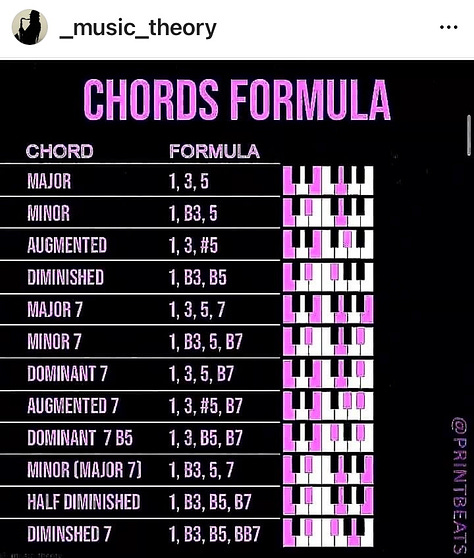
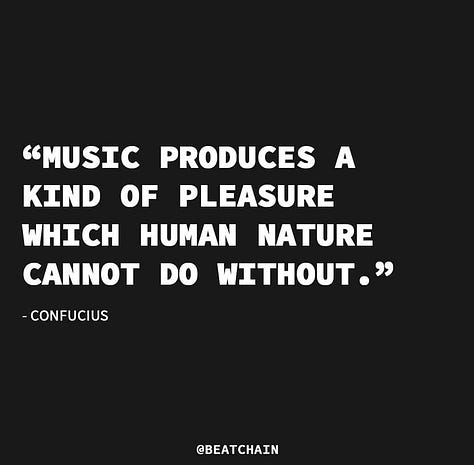
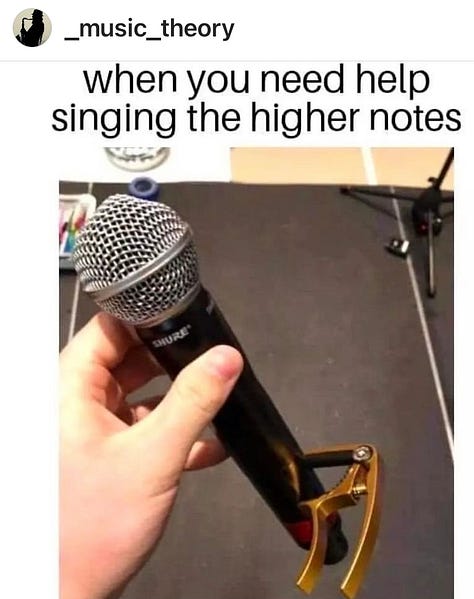
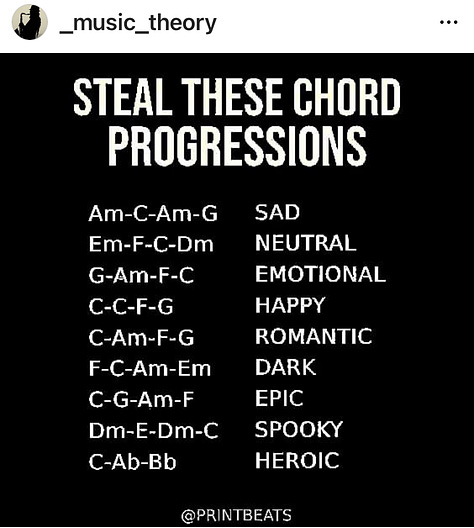
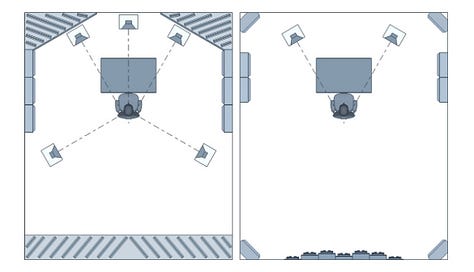



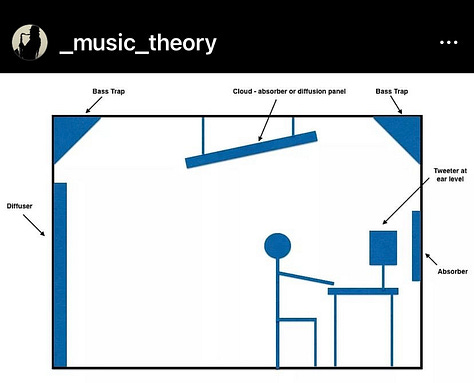
Odds and Ends: Occasionally I include a praise band type Christian song in the “Odds and Ends/A Song To Play” section. This was always a congregation favorite and a blast to play - uptempo and plays a little faster than the 94 BPM tempo that shows on the chart - 4/4 time, Key of GMaj - pretty easy chords - watch for when the BMaj pops up.
[Verse 1]
You are not alone if you are lonely
When you're feeling frail, you're not the only
We are all the same in need of mercy
To be forgiven and be free
It's all you got to lean on
But thank God it's all you need
[Chorus]
And all the people said Amen, whoa oh
And all the people said Amen
Give thanks to the Lord for His love never ends
And all the people said Amen
[Verse 2]
If you're rich or poor, well it don't matter
Weak or strong, we know love is what we're after
We're all broken but we're all in this together
God knows we stumble and fall
And He so loved the world He sent His son to save us all
[Chorus]
And all the people said Amen, whoa oh
And all the people said Amen
Give thanks to the Lord for His love never ends
And all the people said Amen
[Bridge]
Blessed are
The poor in spirit who are torn apart
Blessed are
The prosecuted and the pure in heart
Blessed are
The people longing for another start
For this is the Kingdom
The Kingdom of God
[Chorus]
And all the people said Amen, whoa oh
And all the people said Amen
Give thanks to the Lord for His love never ends
And all the people said Amen
[Repeat Chorus]
[Outro]
And all the people said Amen
Cheers, and keep playing!
Michael Acoustic
“It’s never really final - you just run out of things you can bear to change…”





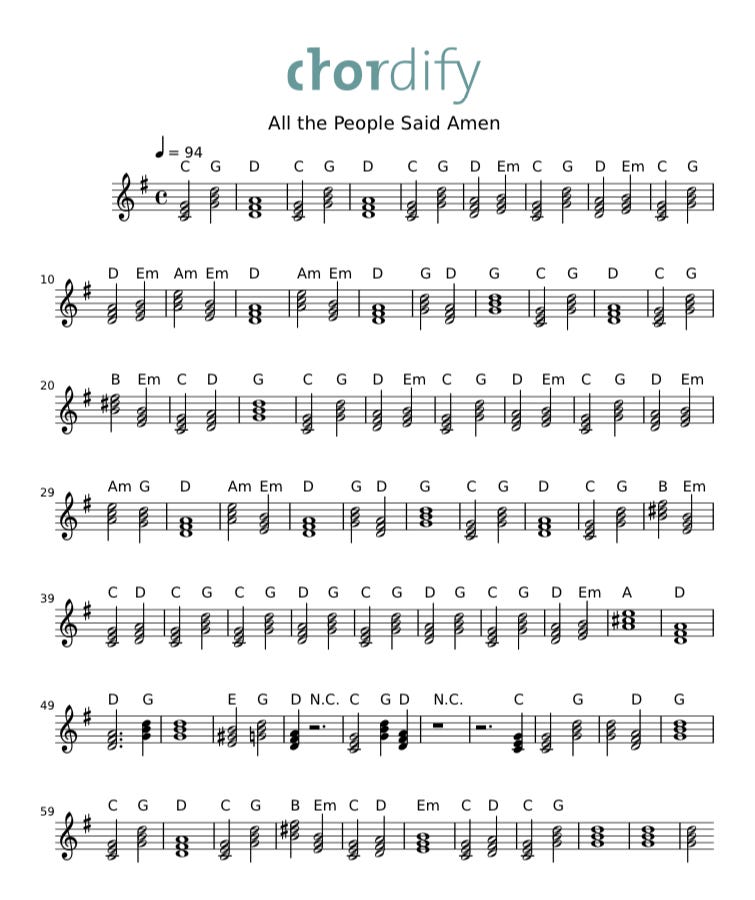
I find these polls to be super unhelpful in terms of offering useful feedback but entertaining nonetheless! Hope it provides you with some usefulness! For the record, I feel equally good with 1 or 2 posts a week. Just to make it even more muddy!